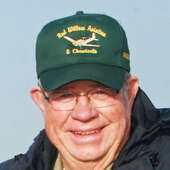- Sweatshirts, Jazzercise, and an unforgiving political climate (11/19/24)
- After the election: Lessons from history (11/5/24)
- Candy or cash: candidates and causes trick-or-treat for donations (10/29/24)
- You are fired! (10/1/24)
- Enduring heritage: Model T’s and Nebraska’s Unicam (9/24/24)
- YMCA project, coming changes and another attack (9/17/24)
- Class of '55 to share memories for Heritage Days (9/10/24)
Opinion
Prairie fires and our changing countryside
Tuesday, April 26, 2022
We here in McCook have been fortunate to miss, so far, the Southwest Nebraska grass fires. To date two firefighters dead and too many farmsteads destroyed. For those affected it is hard to appreciate how their lives will be altered. Roads closed to travel. Dry conditions and strong winds are spreading the devastation. Hopefully, relief will be in sight soon.
All the above is truly not unusual for this part of the world in which we have chosen to live. For thousands of years, prior to the arrival of the European settlers, this whole country was a verdant prairie. It was all covered with native grass ranging from short buffalo varieties to the tall bluestem. Buffalo, more properly bison, and a few more herbivores grazed but did little to keep our prairie short. The thickness of the grass cover depended on the year’s rainfall which probably varied from year to year just as it averages out today. In winter our prairie grasses all became dormant and flammable until April or so. The very few people that occupied this area weren’t much of a factor as they were nomads living in small villages. Primary fire starters were the occasional lightning strikes from spring thunderstorms. There was lots of fuel when a fire got started and they burned for miles sometimes as far as the Republican River to the Platte.
The native Americans when they saw fire coming packed up their tepees and moved out of the way. The animals living on the prairie simply migrated out of the way as there were no fences to trap them. Thus it was for thousands of years.
The huge prairie fires burned any trees along the way and that is why there were no trees anywhere except on the small islands of our few rivers. Just miles and miles of verdant prairie. My dad told of visiting with my great grandmother who with her civil war veteran husband homesteaded south of Culbertson. They had built a south-facing dugout on the bank above the Driftwood “Crick”. When she washed clothes she hung them out to dry on the tallest trees around -- a thicket of wild plums. No trees deciduous or evergreen in the entire vicinity.
Things changed with the arrival of our European ancestors. Roads were built with borrow ditches where the grass grew luxuriant and is rarely grazed or mowed. Fences were built to contain their grazing animals. Farmsteads were constructed, permanent and unmovable. In this country most planted windbreaks with evergreen trees to temper the winds. Most windbreaks contain tall ungrazed carpets of grass. It seems in our DNA to plant trees and trees grew wild along the streams. Birds planted cedar trees wherever in the pastures. Controlled grazing was done to conserve moisture for next year's grass crop. Modern farming practices encourage leaving crop residue standing to encourage trapping snow and conserve soil moisture. All is fuel for wildfire when started in a strong wind.
Electrical lines were strung mainly along the roads and sometimes trees grow into them. In a strong wind, trees have been known to pull a powerline down and the sparks start fires. People have been known to toss live cigarettes out into the grassy road ditches and start fires. All that in addition to lightning strikes from spring thunderstorms can start the ample foliage burning.
Once started a wildfire is reported and fought by local fire departments. Yours truly served as a fireman on a rural department and fought many a pasture fire although never in a wind gusting to over 50 miles per hour. Neighbors bring tractors and discs to till ahead of fire lines to stop the flame front. Where center pivot irrigation systems exist running the pivot can stop the spread of flames but those aren’t very portable and can’t be moved to protect a farmstead. Unfortunately, cattle move to avoid incoming flames but become trapped by fences and all too many are lost.
No our great plains with their sea of grass and crop residue are still exposed to the danger of wildfires. High shifting winds can make those fires uncontrollable and cause terrible damage to anything in their path.
Thankfully as was so well demonstrated in our recent conflagration every fire department for miles around responded to help any way that they could. Even the State of Kansas sent an old S2F firebomber to attempt to control the flames. The Nebraska Army Guard also sent a couple of Black Hawk helicopters each equipped with a fire bucket that they could lower into a body of water and then spread that water on the flame front to help control the spread of fire.
It was interesting to park at the McCook Airport and watch the Blackhawks land for fuel and maintenance and see the old “Stoof” taxi in, stop with engines still running, and get pumped a load of water by a local fire truck. Once full he would taxi for takeoff and head back east total elapsed time of about 10 minutes.
We can all help, and many are, by donating supplies to our local fire departments who in turn will distribute them to their fellow units in need. Churches are organizing to help. So many have stepped forward to help those in need of shelter and that need will continue. May God bless all of you who have stepped forward to help our neighbors in need. It is a wonderful community in which we have chosen to live.
That is how I saw it.
Dick Trail

